The genealogical chart in Genesis 10 lists Ham (Khem/ Khawm/Kam/Cham) as the paternal father of the Black Afrikans from which Egypt, Babylon, Persia, the Kushites/Nubians originated. Ham had four sons (Genesis 10:6): Cush (Ethiopia), Mizraim (Egypt), Phut (Libya/East Afrika), and Canaan (Palestine). The ancient Egyptians were identified in the Bible as Hamites/Khemites (Psalm 106:21-22; 78:51; 105:27), and have descended through the line of Mizraim which is the name by which Egypt is called in the Hebrew Old Testament. The word Egypt comes from the Greek word Aigyptos/Aegyptos meaning Black.
Ham, one of Noah’s sons and the direct ancestor of the Egyptians, was Black. The Bible calls Egypt the Land of Black people, and repeatedly referred to Egypt as the Land of Khawm /Ham, thus clearly associating Egypt with Ham. (Psalm 78:51; 105: 23, 27; 106:21, 22).
One of the many names for Egypt in the ancient Egyptian language is KM.T or “Kemet”, which is an ethnic term derived from the word KM.T (Khem/Khawm/Cham/Ham) which means “burnt or Black”. Kemet can also mean "black land or soil", but this use of KM.T to mean "black land" was to distinguish it from the "desert" or "red land" beyond the Nile valley. However, whenever KM.T is used to mean the "people of Kemet" or "people of the black land”, it is translated as "Egyptians".
This ancient Egyptian word “KM.T” has been deliberately misinterpreted by Eurocentric Egyptologists to mean only “the Black land” in an attempt to give the idea that KM.T could not have meant “Black People”, “Black Nation,” or “Black City”, so as to give the impression that the Egyptians were only referring to the blackness of the soil and not their skin. This was because Egyptologists refused to accept that the Egyptians were describing themselves as Black and their country as “The Black Nation” or “The Black City” , because they wanted to separate Egypt from Afrika in order to classify it as a white nation.
Western historians, Egyptologists, and professors have for a long time been disseminating misinformation about the word Kemet, by suggesting that it refers only to the colour of the land and not to the colour of the ancient Egyptian people. This deception was deliberately concocted by Egyptologists, Eurocentric scholars and Euro-American historians based on a section of Herodotus' statement that Egypt is a “land of Black soil,” completely ignoring the fact that he also said that the people of Egypt “…. are black with woolly hair”.
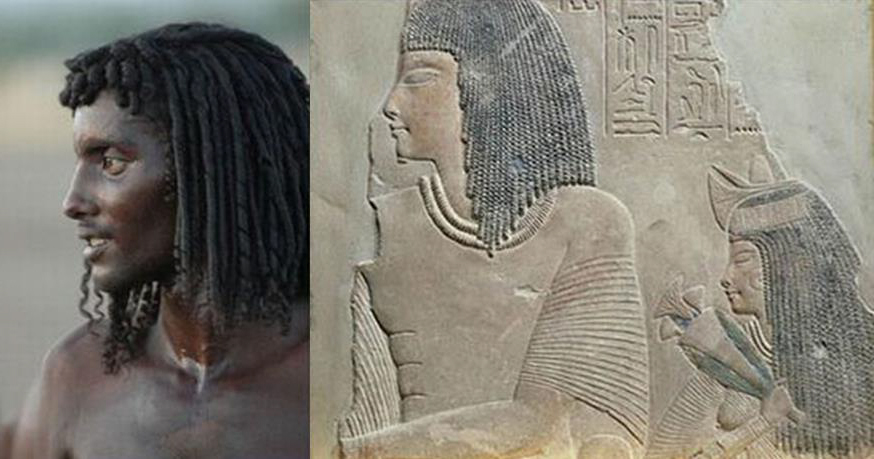
Note the Egyptian man in comparison to the wall sculpture
The Eurocentric scholars eventually admitted that the explanation in the hieroglyphs could not have been referring only to the “black land” but also to the “black country” or “black nation”, so those erroneous texts should be revised to reflect this truth. It is ridiculous to continue the lie of a white Egypt when the ancient name literally means the exact opposite, - Black.
Here is an example of the kings who ruled from the 1st to the 5th dynasties of the early Egyptian period which European historians claim was dominated by white rulers.
1st dynasty (3890 - 2686 BC). Narmer (Aha/Menes) was the 1st unifier of Upper and Lower Egypt.
2 nd dynasty (3890 - 2686 BC). Hotepsekhemwy.
3 rd dynasty (2650 - 2575 BC). Sanakhte was the 1st Pharaoh of the 3rd dynasty of ancient Egypt.
4 th dynasty (2575 - 2467 BC). Pharaoh Khufu was the 2nd king of dynasty 4 of the Old Kingdom.
5 th dynasty (2465 - 2345 BC). Userkaf was the founder of the 5th Dynasty.
European professors have deliberately tried to mislead the world by painting a picture that Egyptian civilization was created by people who came from Asia, yet they cannot produce any Asian parent to substantiate this false claim. There are no buildings, writings, or cultural evidence that provide any clues to show that anything came out of Asia which could have produced what was found in Egypt, but on the other hand, there is plenty of evidence which prove the opposite to be true, including these words from the ancient Egyptians who proudly identified themselves as Black Afrikans, as documented in the Papyrus of Hunefer.
"We came from the source of the Nile, the foothills of the mountains of the moon where the God Hapi dwells, and settled in Egypt”.
A map will point out that they either came from Ethiopia or Uganda, so using the Egyptians own words as to where they came from, that would either be from the hinterlands of Afrika, up river, up the Nile, near either Mount Ruwenzori or Mount Kilimanjaro, which would have taken them into Ethiopia or the Uganda, Kenya, Tanzania regions.
The ancient Egyptians used this one term to describe themselves, KM.T or Kam-Au which literally means Black men, Black people or Black God-people, and they called their country Kemet (Kamit /Khemit), which means “land of the Black people” or “the Black Land”.
The term KM.T represents a collective noun that describes the whole people of Pharaonic Egypt as a Black people, and this is the strongest term existing in the Pharaonic (Egyptian) language that means Black.
Take note of the carving on the hieroglyph below where to the left is a symbol that looks like a little stair-step. This is the Medu Netjer (hieroglyphic) symbol for KM. The symbol that looks like half a ball is the hieroglyph for T, and these symbols together form KM.T (Kemet) along with other terms like chemistry, chemical, and Kham from this root.
Note also the two little people sitting beside this symbol. This is the symbol for Black People, in other words, “the Black people of the Black land”. So the Egyptians have given us in their own words not only a physical description of themselves, but also the term they used to describe themselves which is KM.T, meaning Black people of the Black land.
The original people of Kemet never once referred to themselves as Asian or European, and were never shown with white or pale skin on any authentic artefact until after the foreign invasion period.
The Egyptians made no distinction between themselves and the Nubians in the temple or in the tomb of Rameses III. For example the image on the left is Nubian; the one in the middle between the Semite and the Asian is Egyptian. This shows that the Nubian and the Egyptian are physically identical to each other which explains why they are both portrayed as Black.
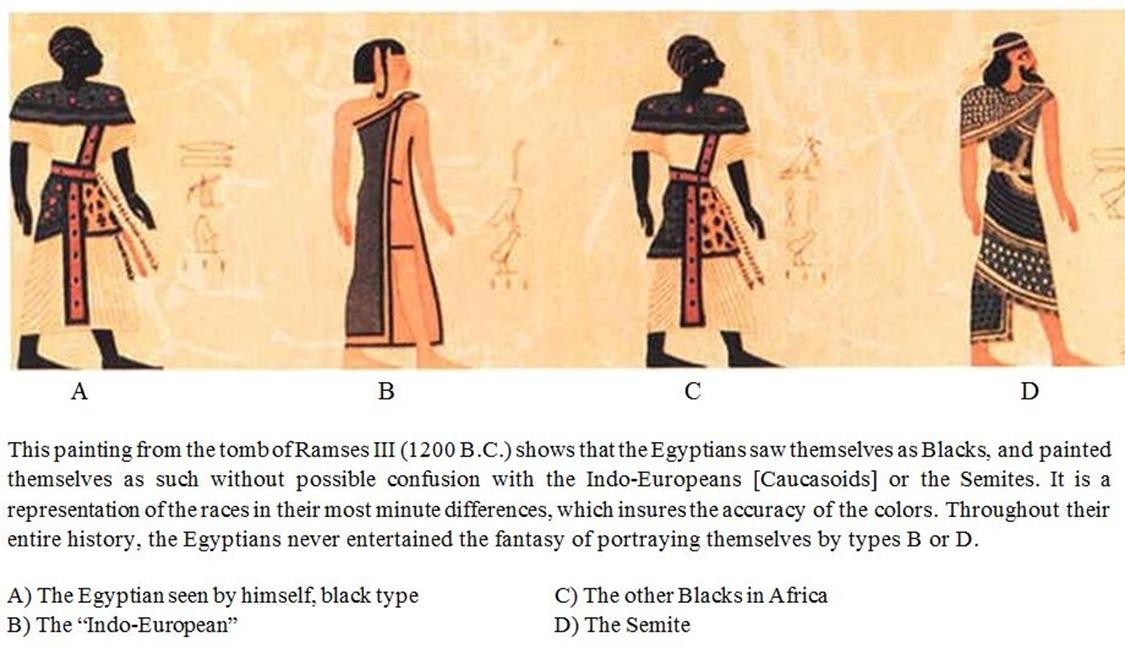
Besides the Biblical proof available to support the Black origin of Egypt, there was an extensive range of tests done by Dr. Cheik Anta Diop in the course of his Black-Egyptian research, in an effort to dispel the myth that the original Egyptians were not Black. These included accurate bone structure measurements; meticulous studies in the several related areas of anatomy and physical anthropology; examination of the epidermis of the mummies of Egyptian kings to verify their melanin content; comparison of modern Egyptian and West Afrikan blood-types; detailed Black-Egyptian linguistic studies, the authentication of Black-Egyptian cultural traits; the writings of early Greek and Roman travellers and other scholars who described the physical characteristics of the ancient Egyptians as pure unmixed Blacks.
This is what Constantin François de Chassebœuf, comte de Volney in his “Travels through Syria and Egypt in the Years 1783-1785” (London: 1787), p. 80-83 wrote about the Egyptians.
"When I visited the Sphinx, I could not help thinking that the figure of that monster furnished the true solution to the enigma (of how the modern Egyptians came to have their "mulatto' appearance) (its features) were those of the Negro. The Egyptians therefore must have been real Negroes, of the same species of the natives of Afrika. How are we astonished when we reflect that to the race of Negroes, at present our slaves, and the objects of our extreme contempt, we owe our arts, sciences, and even the very use of speech; and when we recollect that in the midst of those nations who call themselves the friends of liberty and humanity, the most barbarous of slaveries is justified, and that it is even a problem whether the understanding of Negroes be of the same species with that of white men!
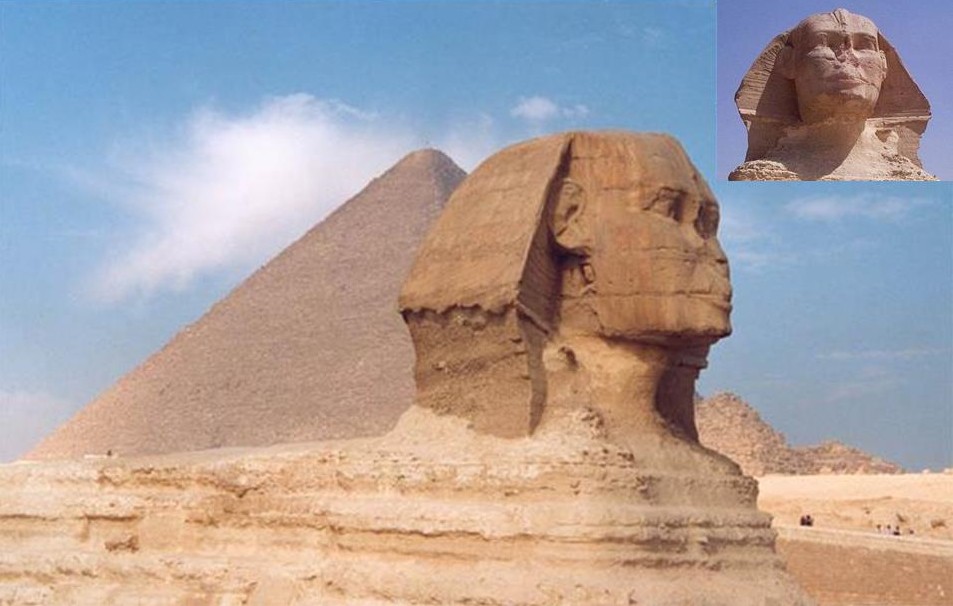
In other words the ancient Egyptians were true Negroes of the same stock as all the autochthonous peoples of Afrika and from the datum one sees how their race, after some centuries of mixing with the blood of Romans and Greeks, must have lost the full blackness of its original colour but retained the impress of its original mould".
Around 332 B.C Alexander the Greek entered Egypt and Caucasians soon began to arrive in droves. After this period there was a heavy mixing with the European and Arab invaders that produced the present day light-skinned Egyptian which Eurocentric students delight in falsely promoting as the original physical stock of the Egyptian people. Until the Islamists took over ruler ship around 640 A.D., Egypt was ruled by White Greeks and Romans who adopted all the paraphernalia and customs of the Egyptian Pharaohs, including the creation of white statues and also Mummification for 972 years, which was ample time for the Turks of Egypt and the Europeans to swap, mix, misidentify and modify any original creations to represent themselves.
However, when the original Egyptians were at the pinnacle of their glory they were not a mixed people by any stretch of the imagination. Miscegenation occurred mainly during the middle dynasties when foreign people migrated to this great land and started intermarrying with the locals, eventually triggering the downfall of this great Black Civilization. The arrival of the Caucasian signalled the death of this ancient civilization and the beginning of his rise to power.
The white supremacists, professors, scholars and historians would like to mislead everyone into believing that Egypt was originally a white nation until Blacks arrived and intermixed with the populace which resulted in the destruction of Egypt, causing it to become a decadent and degenerate society as a consequence of this heavy saturation of Black blood. They even created a rule of thumb which states that any civilized white country will revert to a lower level of culture once the population becomes excessively mixed with alien genes. Portugal is cited as an example, but they never point out that Europe was once living in the dark ages before the Black Moors arrived to uplift and bring them out of their barbaric state and into the light of civilization.
Obviously modern Egypt would have changed considerably as a result of the waves of invasions by the Arabs and other foreign people which would have impacted heavily on the colour variations of modern day Egypt. White Egyptologists focus only on the current world of the white and mixed people of the Greco-Roman period, deceptively introducing the idea that the ancient Egyptians had always looked that way physically which is a total lie.
Modern Egyptian Rulers After Black Rule
Egyptian
Greek
Roman
Turk
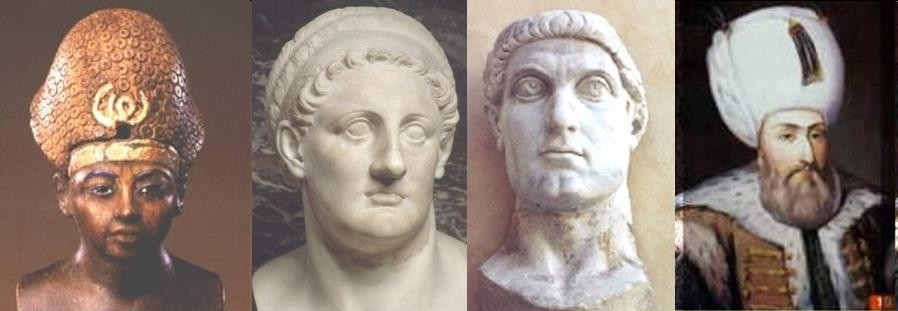
Amenhotep III 9th King 18th Dynasty
Ptolemy I Soter
Emperor Constantine
Ottoman Sultan Selim I
In fact, when white people visit Egypt, the locals refer to them as Khawaaga which means foreigners, but when Afrikan Americans visit they are often mistaken for native Egyptians and referred to as Masri or Egyptians. This is because Egypt has always been a Black Afrikan nation.
Since the Cairo Symposium of 1974, the Caucasoid origins of Egypt along with the western Asiatic theory have gradually been abandoned in most scholarly writings and replaced with a new “mixed race” theory, but no evidence has been provided to support this new hypothesis, yet these far-fetched ideas continue to flourish in the mainstream media like the television, modern paintings, cartoons, comic books and museum exhibits, all of which focus only on the foreign period of Greco-Roman occupation that marked the fall of the great Black Egyptian empire. This is because the media is a part of the arsenal in the White man’s vendetta against Black people.
The following ancient Egyptian words are all variations of the term KM.T, (KEM) and can be found in "An Egyptian Hieroglyphic Dictionary" by E. A. Wallis Budge, Dover, NY. Words in the brackets are word classifiers with the English meanings.
Kem, kame, kmi, kmem, kmom = to be black
Kememu = Black people (Ancient Egyptians) in Ancient and modern Egyptian (Kmemou).
Kem [khet][wood] = extremely black, jet-black
Kemet = any black thing. - pronounced Kemé "t" is silent
Kemet [nu][community, settlement, nation] = Black nation = Ancient Egypt.
Kemet [Romé][people] = Black people/ Ancient Egyptians.
Used as an adjective
kem; kemem; kemom - black
kemu - black (m)
kemet - black (f)
himt kemet - "black woman"
himut kemet - "black women"
Used as a noun
kemet - any black person, place, or thing
A determinative is then used to be more specific:
kemet (woman) - "the Black woman"; ie, 'divine woman'
Kemet (nation) - "the Black nation"
kem - a black one (m)
kemet - a black one (f)
kemu - black ones (m)
kemut - black ones (f)
kemeti - two black ones
Used for Nationality
Sa Kemet - a man of Black (an Egyptian male)
Sa.t Kemet - a woman of Black (an Egyptian female)
Rome.t Kemet - the people of Black (Egyptians)
Kemetou - Blacks (ie, 'citizens')
Kememou - Black people (of the Black nation)
Other usages
Sa Kem - "Black man", a god, and son of
Sa.t Kem.t - "Black woman", a goddess
kem khet (stick) - jet black
kemwer - any Egyptian person, place or thing ('to be black' + 'to be great')
Kemwer - "The Great Black" - a title of Osiris - the Ancestor of the race
Using the causative "S"
S_kemi - white haired, grey-headed man (ie, to have lost blackness)
S_kemem - to blacken, to defile
Some interesting Homonyms
Qemau; Qemamu - The Creator
Qemi - the south, Upper Egypt
qemati - statue, image - same as kemti
qemaiu - created beings
Deshret - the opposite of Kemet
deshr.t - any red (ie, non-Black) person, place, or thing
deshr.t (woman) - "the Red woman"; ie, 'evil woman'
deshr.t (cow) - "a Red cow" - ie, the 'devil's cow'
deshru.t - red ones (f) -- White or light-skinned people; Devils
deshreti - two red ones
For decades, The National Geographic Magazine has played a key role in misrepresenting ancient Egyptian images. It started with the "so called" authoritative scholarly article issued in October 1941 that contained over 20 paintings by H. Herget showing wild fantasy drawings of pale-skinned Egyptians and short Afrikans called "Deng" in Egyptian or "Pygmy" by modern Westerners as Black skinned obscene caricatures resembling ape-like creatures with a leash around the ankle and ridiculously large red lips. The supporting text was prepared by William Hayes from the Metropolitan Museum of Art in New York. This most vile and absurd anti-Black painting from that 1941 series shows that the editors of the National Geographic which has set the standard and continues to be a leader in publicizing make-believe Caucasian images of Egyptians, are completely shameless in their racist misrepresentations of ancient Black civilizations.
Euro-American scholars continue to use these nonsensically outrageous images today to illustrate their publications in an effort to enhance their scholastic writings. This ongoing smearing and deliberate distortion of ancient images demonstrate the persistent attempt to continue denigrating Black people, but the question is why?
From the beginning of time, the true origins of the white man’s history have remained carefully and deliberately hidden from the public domain. It is very recent, only going back to around 4000 B.C. in comparison to that of the original Black people of Afrika.
The ancient Egyptians in depicting themselves through their art, used brown paint to indicate Black skin, as illustrated in this painting. Black signifies either Sacred, holy, powerful, reborn or resurrection.
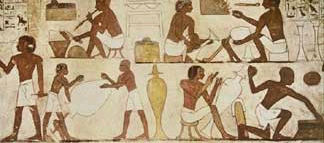
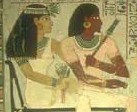
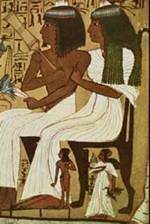 Yellow skin is the traditional colour used to paint women because it indicates a physical weakness in comparison to the man as depicted in the painting on the left.
Yellow skin is the traditional colour used to paint women because it indicates a physical weakness in comparison to the man as depicted in the painting on the left.
Politically speaking this was not the case with Egyptian women, since they were regarded as equals. Note the man has a brown skin complexion while the woman has yellow skin.
However, after the revolution of Akhenaten, social equality was portrayed by painting both the male and the female in the same brown hue, as seen in the image on the right.
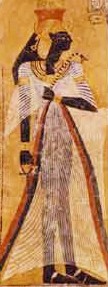
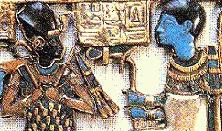
Black paint indicates authority or power, as illustrated in this example portraying Amhose Nefertari on the left, who is shown with black skin.
In the painting on the right, the God Ptah is rendered in blue which indicates that he is a god of creation and regeneration, while Tutankhamen, who is being reborn, is shown changing from brown to black which represents the colour of transformation and resurrection.
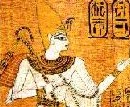
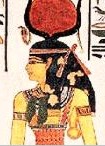
The white skin colour in Egyptian art represents a recently deceased person as depicted in the painting on the left.
The flesh tone of the gods is represented by a gold colour as shown in this portrayal of the Goddess Hathor on the right.
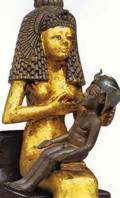
On this statuette which is located in the Cairo Museum, note the golden colour of the Goddess Isis and the brown / black colour of Horus her son.
Original Black Afrikan images on the ancient Egyptian temple walls are generally removed and hidden from the view of visitors. Since the average tourist does not explore beyond a set route where the Black Afrikan images are located, tour guides, who are typically Arabs, tend to steer the visitors along specific temple paths, pointing out only the carefully selected images.
Therefore tourists do not get to see all the sections of the vast Karnak Temple complex, which also includes an open-air museum, statues, wall carvings, shrines, smaller temples and halls.
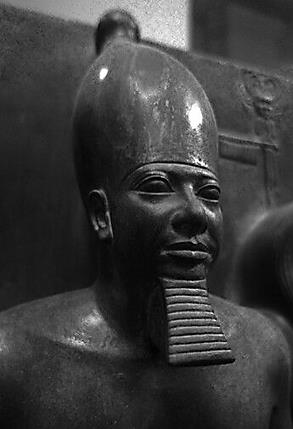
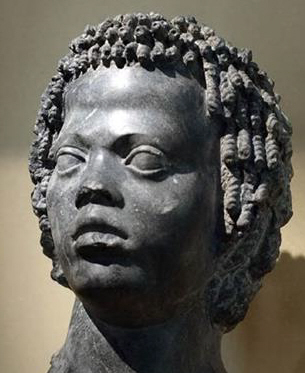
The main objective of this body of conspirators is to erase all knowledge of a Black Egypt by deleting as many Negroid images from the ancient Egyptian historical records. This is in harmony with the views of the racist Euro-Egyptologists from the 19th and early 20th century who concocted the derogatory views that Black people did not have any place in ancient Egypt, as they tried to convince a gullible world that Egypt was established by a white or Semitic race. These speculations were rampant among Euro-Egyptologists and became the inspiration for H. M. Herget’s 1941 National Geographic Magazine paintings of pale-skinned Egyptians as well as the invented white images of Egyptians created by Hollywood that still continue to mislead the public 75 years later.
A range of techniques have been used to modify or deface the Negroid images, which include skilfully changing the structure of the noses on statues by:
- Using some sort of sanding machine;
- Adding false noses;
- Remaking or destroying the faces on the tomb and temple walls;
- Lightening the colour of the face and body paint on statues and paintings;
- Completely removing the paint on statues and paintings to make them seem white;
- Destroying the lower facial structures like the chin and jaw areas;
- Inserting false bluish inlaid eyes;
- Plastering white cement on top of the temple images during conservation work;
- Creating outright forgeries.
These acts lead to a widespread assault on ancient Black images.
For example, these images show the extent to which people would go in damaging the noses and lips of Afrikan statues in the attempt to hide the Black identity.
Image I displays the Egyptian God Amon/ Amen/ Amun, who was the patron deity Thebes. The sayings "Amen" or "So Mote it Be" said at the end of a prayer, spell, or ritual which means "so as I will it, so shall it be done", was done after the name of this ancient Egyptian God. "Amen", a word which the Hebrews adopted and passed onto Christians to implore this unseen God Amon, is still used to end prayers in Jewish and Christian Religions even today.
Image II shows Queen Tiye, Pharaoh Akhenaten’s mother.
Image III shows Senusret, founder of the City of Athens.
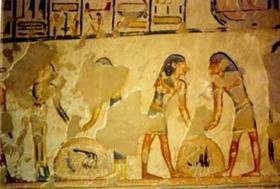
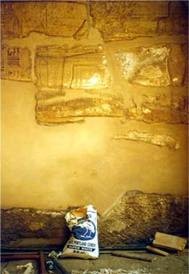
Note the facial damage done to these statuettes from the Valley of the Kings tomb (left), which is the common method used in the intensive effort to destroy Black images.
This original wall surface on the right was completely destroyed and then plastered over with white cement.
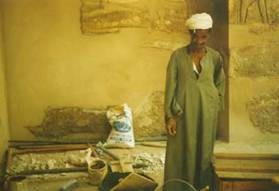
On the left a modern Egyptian government worker is posing in front of this extensive wall damage just created.
Look at the evidence of this destructive action, paying attention to the scaffolding, piles of wall material, tools, water, and the bag of white cement used to paste over the wall surface after the images and inscriptions are broken away.
In the 1st image below, the face of Rameses II has been completely obliterated, and in the 2nd image a line was intentionally chiselled through his face in an effort to alter the shape of his nose. Compare the war helmet of Rameses II to the head of a native Black Afrikan Tutsi in the 3rd and 4th images.
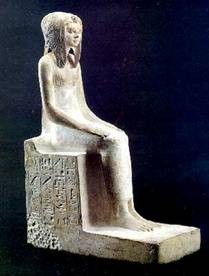
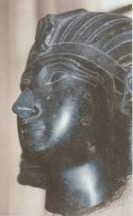
This granite statuette inscribed with the name of the famous Queen Tetisheri was one of the great forgeries of the 19th century highlighting its European facial features.
It was displayed around the world as authentic until 1984 when it was discovered to be a forgery, but not before it had fooled even the so called “experts” and deceived the world for about a century.
This world renowned statuette is now known to be a complete fake.
On the right the administrators of an Italian museum gave Thutmosis III a new nose job in a big attempt to change his Negroid appearance.
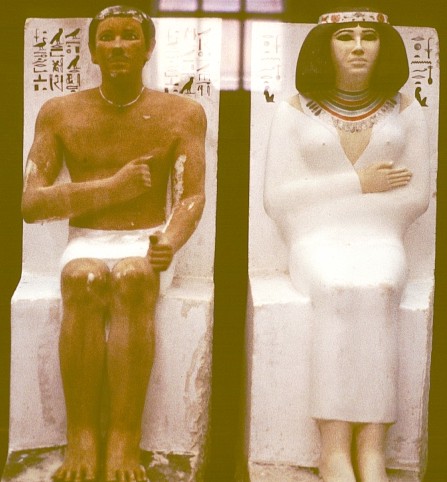 The Rahotep and Nofret statues on the left are seated in chairs with Medu Neter inscriptions near the heads. These statues are now known to be among the greatest forgeries in the history of ancient Afrikan archaeology.
The Rahotep and Nofret statues on the left are seated in chairs with Medu Neter inscriptions near the heads. These statues are now known to be among the greatest forgeries in the history of ancient Afrikan archaeology.
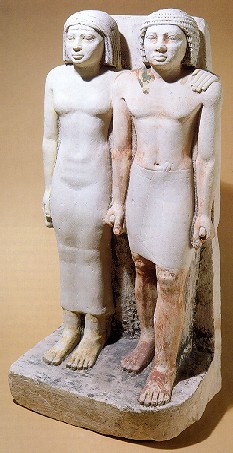 This statue from the Tomb of Ikhetneb on the right has practically lost all of its original paint on the faces and upper body, though enough of the original paint is still apparent on the legs and feet. Clearly, the dark paint was intentionally removed from the face and upper body areas to give the images the illusion of a white-skin appearance.
This statue from the Tomb of Ikhetneb on the right has practically lost all of its original paint on the faces and upper body, though enough of the original paint is still apparent on the legs and feet. Clearly, the dark paint was intentionally removed from the face and upper body areas to give the images the illusion of a white-skin appearance.
Keep in mind that museum artefacts are generally handled, restored, worked on and repaired behind the scenes prior to being displayed in public, and the period between the initial excavation of an artefact and the time it is displayed can last for several years during which time many fraudulent changes are deliberately made to the statues and paintings. The majority of modifications can be detected through carefully inspecting the artefacts in any collection or museum, where they can be noticed as having been tampered with, re-worked to hide their racial identity, “de-Afrikanized” completely, or changed from Afrikan to Caucasian or another mixed group type to deceive the world and conceal the truth about ancient Afrika.
The diverse, extensive group which performs the behind-the-scenes work in addition to conspiring to carry out these wicked acts of destruction, transformations and re-creations, involve
Archaeologists, Egyptologists and Government Workers, (who dig up, record, and decide the fate of the artefacts);
Restoration and Conservation Workers, (who restore and piece together the broken artefacts);
Museum Workers and Officials (who comprise the final group that handles the artefacts before they are displayed publicly);
European Travellers and Adventurers, (who consist of looters, treasure hunters and plunderers).
During the 19th century, a considerable number of ancient Egyptian artefacts were excavated but not properly documented with on-site photos or detailed descriptions as is the accepted practice within archaeological circles.
According to the New York Times Magazine September 15, 1997, VOL. 150, NO. 11, Ancient Nubia (Sudan): “Around 5,000 years ago, a rich and powerful nation called the kingdom of Kush (also referred to as ancient Nubia) was a centre of culture and military might in Africa. Ancient Nubia had a wealth of natural resources such as gold, ivory, copper, frankincense and ebony but they also produced and traded a variety of goods such as pottery. The Nubians formed the foundation of the Proto-Dravidians, Proto-Elamites, Proto-Mande speakers and West Atlantic people.
Ancient Nubia's lands are now part of modern Egypt and Sudan. Its geographic position meant that much of ancient Nubia's development is connected to that of ancient Egypt. In fact, Egypt ruled much of Nubia between 2000 B.C. and 1000 B.C., but when Egypt collapsed into civil war, Nubian kings ruled Egypt from around 800 B.C. to 700 B.C.
Nubia is the homeland of Africa's earliest black culture with a history which can be traced from 3800 B.C. onward through Nubian monuments and artifacts, as well as written records from Egypt and Rome.
Excavations in Sudan are revealing that this area, formerly called Nubia, could have been the cradle of African civilization. Teams of archaeologists from the US, Europe and Sudan are finding antiquities that show a sophisticated and original culture that could have influenced Egypt.
The latest crop of discoveries is helping put such ideas to rest. French archaeologists, for example, have found exquisite ceramic figurines, bowls and funerary objects at sites that date from at least 8000 B.C. They are as old as any Neolithic sites in Africa and predate prehistoric finds in Egypt by a staggering 3,000 years. This strongly suggests to Hassan Hussein Idris, director of Sudan's National Board for Antiquities and Museums, that ancient Nubia might have been an important source of Egypt's civilization.
Despite all the information available which proves that Egypt is a part of Afrika and that the ancient Egyptians were Black, Europeans still insist on casting white actors to play the role of Black Egyptians in their movies. This shows that if they are willing to blatantly lie about this in order to continue pushing the myth of white superiority, it should not be difficult to understand that they will continue to follow this same trend when they utilize the mass media like the radio, television, magazines, newspapers, and even social media.
Not only were the ancient Greek and Roman scholars consistent in their description of the ancient Egyptians as Ethiopians/Afrikans, but they also created art to show they were indeed Afrikans. Their eyewitness accounts are also in sync with today’s science of body type and genetics as extracted from the human remains of that time period.
Circa 425 B.C., Herodotus wrote, “The Colchians who are Egyptians and have Black skin and Wooly hair and descend from the army of Sesostris…”
Diodorus Siculus, circa 60 B.C. in the Bibliotheca Historica wrote, “They [the Ethiopians] say the Egyptians are colonists sent out by the Ethiopians, as Osiris being the leader of the colony”.
Diodorus in his volume “History, Book III: 2” wrote, “The Nubians are believed to be the first human race on earth, and most of their customs and traditions were adopted by the ancient Egyptians. To the Greeks, they were known as Ethiopians and Nubia as the land of Punt, the land of gods”.


© John Moore - Barbados, W.I. (March 2000) ©. All rights reserved.